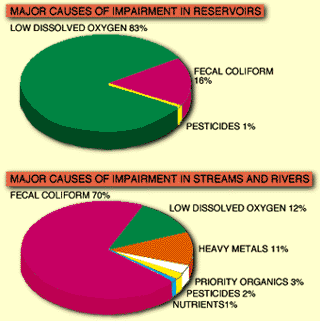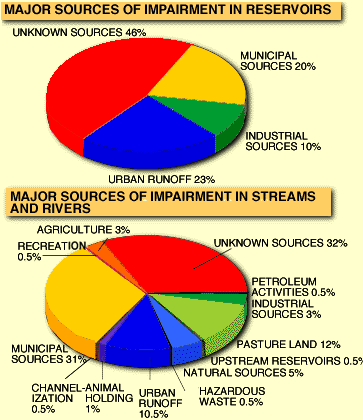

NEXT PAGE * PREVIOUS PAGE Go to page 1*2*3*4*5*6*7*8*9*Notes

Texas has approximately 191,228 miles of streams and rivers, of which 40,194 miles (21%) are considered perennial, meaning they have a sustained flow throughout the year. In addition, Texas has nearly 8 million square acres of wetlands, more than 3 million square acres of reservoirs, and 1,990.(7) square miles of bays and 3,879 square miles of open Gulf water along its 624 miles of coast. All of these waters are afforded at least minimal amounts of protection by the state and federal governments.(17)
There are three different types of water quality standards set by state and federal regulations.
These are:
Today, in Texas, the Texas Natural Resource Conservation Commission is the primary agency responsible for water quality management in the state, although it shares the responsibility with the five other state agencies. Under the Clean Water Act and Chapter 26 of the Texas Water Code, the Texas Natural Resource Conservation Commission has the sole authority to develop and amend surface water quality standards for the state which are implemented via agency permitting programs.
Texas does not apply a single set of water quality standards to all surface waters in the state. Instead, waters are "classified" according to how they are used, and water quality standards appropriate to that use are applied. Some examples of use classifications are "contact recreation" (swimming), "non-contact recreation" (boating) and "public water supply" (drinking water). In monitoring these river and stream segments, the Texas Natural Resource Conservation Commission seeks to determine whether the water quality is adequate for the segment's classified use. Water quality must be higher for drinking water, for example, than it is for boating.
Water quality is protected by regulating certain activities; primarily, the discharge of wastewater from cities and industrial operations is prohibited unless a permit is received from the Texas Natural Resource Conservation Commission and in most cases the Environmental Protection Agency. These wastewater permits regulate the quality of wastewater that will be discharged into a stream, river, lake or bay.
There are three types of wastewater permits issued by the Texas Natural Resource Conservation Commission :
Permits either allow wastewater discharge into a stream, river, lake or bay or they are "no discharge" permits. No discharge permits refer to the disposal of wastewater by irrigation or evaporation. For example, all Confined Animal Feeding Operations of a certain size must obtain "no discharge" permits. Permits normally expire after five years at which time they must be renewed.
The Railroad Commission of Texas issues wastewater discharge permits related to oil and gas activities.
| DOMESTIC AND INDUSTRIAL WASTEWATER DISCHARGE PERMITS AND TOTAL DAILY DISCHARGE FLOW BY RIVER BASIN, 1991 | ||
|---|---|---|
| RIVER BASIN | NUMBER OF PERMITS | DAILY FLOW MILLIONS OF GALLONS/DAY |
| Canadian River Basin | 29 | 31 |
| Red River Basin | 78 | 220 |
| Sulphur River Basin | 46 | 28 |
| Cypress River Basin | 68 | 340 |
| Sabine River Basin | 166 | 1,647 |
| Neches River Basin | 225 | 1,341 |
| Neches-Trinity River Basin | 89 | 214 |
| Trinity River Basin | 435 | 3,997 |
| Trinity-San Jacinto River Basin | 60 | 402 |
| San Jacinto River Basin | 1,027 | 1,961 |
| San Jacinto-Brazos Coastal Basin | 229 | 784 |
| Brazos River Basin | 424 | 2,751 |
| Brazos-Colorado | 51 | 24 |
| Colorado River Basin | 135 | 2,828 |
| Colorado-Lavaca | 33 | 6 |
| Lavaca River Basin | 13 | 5 |
| Lavaca-Guadalupe River Basin | 25 | 23 |
| Guadalupe | 65 | 1,407 |
| San Antonio River Basin | 67 | 1,106 |
| San Antonio-Nueces | 37 | 264 |
| Nueces River Basin | 35 | 20 |
| Nueces-Rio Grande Coastal Basin | 133 | 949 |
| Rio Grande River Basin | 57 | 129 |
| Total | 3,527 | 20,477 |
Source: Texas Water Commission, Summary Report: Regional Assessments of Water Quality Pursuant to the Texas Clean Rivers Act (Austin: TWC, December 1992).
| TEXAS SURFACE WATER QUALITY STANDARDS |
|---|
The Clean Water Act (CWA) requires states to develop and enforce a comprehensive set of water quality standards. There are two components to surface water quality standards:
(2) chemical, physical and biological criteria to protect those uses. The uses which may be established for a water body are:
A water body may be assigned more than one of these uses. Upper and lower limits for common water quality criteria are established for each water body. Some of these criteria, or standards, are:
Not all waters in Texas are protected by site-specific criteria. For example, in Texas, only 14,359 of 40,194 perennial river miles (36 percent) and 1.5 million of 3.0 million acres of reservoirs (50 percent) have been designated for a particular use. All 1,990 square miles of bays and 3,879 square miles of ocean waters have been classified.(19) Classified waters include most rivers and their major tributaries, major reservoirs and estuarine waters. Unclassified waters are those smaller water bodies which have not had a site-specific study analysis performed in order to set site-specific standards. Unclassified waters are protected by general aquatic life standards which apply to all surface waters in the state. The EPA is required to review state water quality standards to ensure they meet the Clean Water Act goals of "fishable and swimmable quality waters."(20) States are required to evaluate and if necessary, revise their water quality standards every three years. While most bodies of water are designated a use to meet these broad goals of swim-ming (contact recreation) or fishing (high or exceptional aquatic life), the Houston Ship Channel and Buffalo Bayou are so polluted that they are designated for navigation purposes only. When the Texas Natural Resource Conservation Commission or Environmental Protection Agency (EPA) considers applications for wastewater discharge permits, it uses these water quality standards to develop limits on the amount and type of contaminants that will be allowed in the discharge. |
As of July 1994, 2,354 municipal wastewater treatment facilities, both publicly and privately owned, were operating with state wastewater discharge permits. Fifty-five water treatment plants, which discharge water during the filtering process, also had state permits. Municipal facilities discharged nearly 3 billion gallons of wastewater per day into Texas surface waters during 1991. In addition to these domestic treatment facilities, there were 1,026 industrial facilities with active state permits in July 1994, which together discharged almost 18 billion gallons per day.(18)
About 15 percent of both industrial and domestic wastewater permits are no-discharge permits, which means that wastewater is evaporated or used for irrigation instead of being discharged into a river or stream. Finally, in 1994, there were 515 Confined Animal Feeding Operations - feedlots, poultry and dairy operations - which were required to obtain no discharge permits from the TNRCC.
Source: Texas Engineering and Extension Service, Texas A & M University System, Basic Wastewater Operation, (College Station: Texas Engineering Extention Service, 1994), 5-1.
Source:Texas Engineering and Extension Service, Texas A & M University System, Basic Wastewater Operation, (College Station: Texas Engineering Extention Service, 1994), 4-3.
Since 1972, the amount of pollution discharged in wastewater by domestic facilities has decreased about 70 percent in Texas. At the same time the amount of waste requiring treatment has increased by 85 percent.(21) This improvement is due mainly to better technology and to requirements that wastewater in Texas be cleaned up to stricter standards. About 67 percent of domestic wastewater produced by municipal facilities receives advanced treatment.(22)
Most discharges in Texas are concentrated near major population centers like Dallas and Houston. The state processes about 200 new or revised industrial permits and about 500 new or revised municipal permits each year. Since 1980, combined industrial and municipal permits have increased from 2,907 to 3,435. While industrial permits have been increasing due to increased economic activity, the number of permitted municipal facilities has actually declined in recent years as some city systems have regionalized their wastewater treatment.

Source: Texas Natural Resource Conservation Commission, State of Texas Water Quality Inventory, 12th Edition (Austin: TNRCC), 129 and 133.

Source: Texas Natural Resource Conservation Commission, State of Texas Water Quality Inventory, 12th Edition (Austin: TNRCC), 129 and 133.

NEXT PAGE * PREVIOUS PAGE Go to page 1*2*3*4*5*6*7*8*9*Notes

Please send questions, comments, or problems with this page to ltarver@mail.utexas.edu..